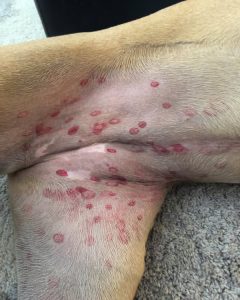If you’ve ever spotted red, inflamed circles on your dog’s belly, your first reaction might be to panic and immediately call the vet. That’s a completely normal response—after all, we love our pets like family, and anything unusual on their skin can feel like an emergency. However, before letting worry take over, you might want to take a moment and breathe. According to recent insights from veterinary professionals, those alarming marks may not be as serious as they look.

The Morinville Veterinary Clinic in Alberta, Canada, recently took to their Facebook page to address a rising concern among pet parents. With more and more calls coming in about mysterious red bites on dogs’ stomachs, the clinic shared a post meant to both inform and comfort.
“We are getting more and more phone calls about red bites on your dog’s stomach,” the clinic explained. “These are a type of fly bite, and dogs generally get them from laying in the grass. They look terrible, but usually do not bother the dogs. They heal quickly on their own and do not require any treatment. These flies are usually around for a few weeks every spring and then go away. We hope this eases any worry that you may have had about your own dog!”
In short, the red marks that look like they might be painful or serious are most likely the result of black fly bites. These flies, which tend to thrive in the spring months, are commonly found in grassy or outdoor areas, and they seem to prefer dogs’ soft belly skin when the pets are lounging on the lawn.
The clinic’s post served as a friendly reminder not to jump to conclusions or rush to the vet without first understanding what might really be going on. Of course, every pet’s health is a priority, but it’s also wise to stay calm and informed.
The message quickly resonated with pet owners all over Facebook. The post was shared widely, and many dog lovers began commenting, sharing similar stories of discovering red bites on their pets and feeling immediate concern. But after reading the post, many expressed a huge sense of relief—especially those who were just about to spend money on an emergency vet visit.
One commenter wrote, “Thank you for the information. I was just getting ready to run out to the vet and spend a good $200 I really don’t have.” That sentiment was echoed by dozens of others who had been in similar situations.
But what are these black flies, and why do their bites look so aggressive? According to Michael San Filippo, a spokesperson for the American Veterinary Medical Association (AVMA), these little pests are very common in North America, particularly in the northern regions. “These appear to be bites from black flies, which are widely spread across North America, particularly the northern latitudes,” he explained.
Though the bites can appear nasty, in most cases, they don’t cause any long-term harm to dogs. Most dogs aren’t even bothered by them, and the marks often disappear in just a few days without any treatment. However, that doesn’t mean you should always dismiss skin abnormalities.
San Filippo and the Morinville Veterinary Clinic both emphasize the importance of remaining vigilant. While black fly bites are usually harmless, other skin irritations or red patches could be a sign of something more serious. Some parasites or allergic reactions can mimic the appearance of fly bites, and if left unchecked, they might lead to more complicated health issues.
“If you notice any unusual bites or injuries or behaviors, you should contact your veterinarian to discuss,” advised San Filippo. “There are a number of factors to consider, such as your pet’s age, medical history, and health status, as well as the specific health threats to your pets where you live.”
Another reason to stay alert is that not all dogs react the same way. Just like humans, pets can have different sensitivities to insect bites. While one dog may barely notice a fly bite, another might experience swelling, itching, or even a more serious allergic reaction.
So what’s the best approach when you see red marks on your dog’s belly? Start by observing your dog’s behavior. Are they scratching, licking excessively, or acting uncomfortable? Or do they seem unbothered? If it’s the latter and the bites match the typical look of black fly bites—small red circles, often not raised or oozing—then it’s likely nothing to worry about. You can monitor the area over the next couple of days. If the spots begin to fade and your dog remains active and happy, then you’re probably in the clear.
However, if the spots worsen, spread, ooze, or seem painful, or if your dog starts acting lethargic, stops eating, or shows other unusual symptoms, it’s time to make that vet appointment. It’s always better to err on the side of caution, especially when your pet’s well-being is at stake.
Additionally, there are ways to help prevent these bites in the first place. Try to avoid letting your dog lie in the grass for extended periods during the height of fly season. You can also ask your vet about pet-safe insect repellents that may help keep black flies and other biting insects away.
In conclusion, while those red bite marks can look concerning at first glance, in many cases, they’re just a seasonal nuisance caused by black flies. They often require no treatment and clear up on their own. Still, staying aware of your pet’s behavior and overall health is crucial. Trust your instincts—if something feels off, don’t hesitate to consult with your veterinarian. It’s always better to ask and be reassured than to miss something important. So next time you see those red spots, remember: it might not be an emergency, but it’s always worth a second look.





